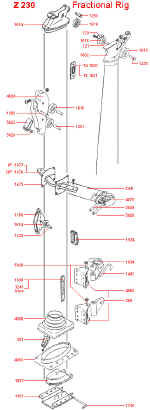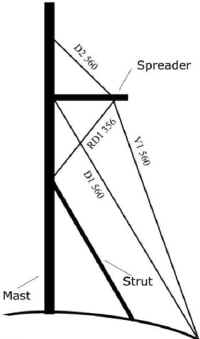|
The B & R Rig
Hunter Marine uses the Bergstrom & Ridder (B
& R) rig on its boats.
Advantages: Here's some of the advantages
of this rig used in the H260.
A
three-legged stool is more stable than a four-legged one. The B & R rig has
the same approach. To accomplish this, the rig utilizes 30 degree swept-back
spreaders creating 120 degrees between each rigging point. This tripod
arrangement is similar to the huge radio towers you see from the highways.
Other
benefits of this configuration.
-
First,
the strength is increased because the loading on the rig itself is decreased.
Less movement of the rig itself means less fatigue on the rigging which is
usually the primary culprit of failures.
-
Second,
another big advantage of this rig is that the swept back spreaders give a great amount of fore and aft
support to the mast, eliminating the need for a backstay.
-
Third, since
there is no backstay, the design of a large, easily handled main and a
small jib make sail trimming and handling much easier than the conventional rigs
with their large genoas. This allows for a more efficient mainsail with a
larger roach for increased performance. This means less work for the crew in
that the power sail is the main.
-
Fourth,
the shrouds are led outboard which reduces compression loads to the deck and
hull while allowing tighter sheeting angles on the smaller jib for better
windward performance. With the addition of the newly created mast struts on the
H260, the
point loading at the mast base is spread among the three points and the extra
support allows for a smaller mast section. This reduction in weight aloft
decreases heeling and pitching moments which creates a more comfortable ride.
Disadvantages:
For the average sailor, the B & R rig takes some getting used to. Also, racers used to tweaking trim with mast bend and traveler will
feel lost.
The downside to having spreaders swept back in excess of 25 degrees is that
this creates a narrow shroud base, which means the mast gets less
lateral support and the shrouds have to pull harder to keep the mast
standing. This creates enormous load pressures. Another major disadvantage
to the swept back spreaders is when running, they restrict how far the boom
can be let out and mainsail
chafe is a possibility. When running downwind it's easier to experience an
unplanned jibe. As a result, I always rig a preventer when running deep. With
the large roach in the main it may not be possible to depower
the main quickly in heavy winds and you round up. Finally, you are forced to
over sheet the main and gybe downwind because you can't set the boat up on a
dead run.
Summary: That
said, we've found the advantages outweigh any disadvantages. The large roach in the main
provides ample power. The boat sails just as fast reefed as it does with a full
main, but the jib is useful for pointing in all but the most windy conditions.
Speed and stability are better sailing downwind on a broad reach, and we
typically use a boom preventer when
sailing off the wind. Once the uppers are set, tuning the lower shrouds is
simple.
A
recent article in Practical Sailor summarized the advantages of the B & R rig thusly: "We think this concept makes the most sense when used with a mainsail
with ample roach and jiffy reefing. With this setup, the compromises when
sailing off the wind and the lack of adjustability are offset by a more
efficient and powerful sail plan...if you want a no-fuss rig with easy
operation, look no further."
A
much longer discussion regarding the B & R Rig can be found at http://www.hunterowners.com/ref/br.html
Tuning the H260 Standing Rigging
Caution: These notes apply only to the H260 equipped with Hunter Marine designed
rigging as described below
Disclaimer: These
instructions are for entertainment only. Check with a professional rigger or
Hunter Marine before rigging any boat. Use of any part of these procedures is at
your own risk. Your decisions,
adjustments and actions must be based strictly on your own knowledge and
research.
Verifying the rigging. Using the main halyard, center the
rig in the middle of the boat by first jamming the halyard in a position so that
the halyard shackle just contacts known point on the port side. Then, with the
same tension, move the halyard to the starboard side to the corresponding
position. After the mast is centered, hang a crescent wrench from the main
halyard just above the gooseneck. The wrench should hang 6 inches away from the
aft face of the mast. When sailing, the
leeward shrouds should NEVER be slack. The length of the forestay can be
adjusted but that's not how you adjust rig tension. If the mast is properly
centered and raked all you have to worry about is making sure you have the
appropriate tension on the shrouds.
Tuning the rigging. Hunter uses Hackensack 316
Stainless Steel 1/8"  (3.2mm) 1X19 cable and 5/32" (4mm) 1X19 cable for the H260. The
Hackensack 1 x 19 Strand cable is strong, with less stretch but is also less
flexible than many types of cable and does not allow for kinks or bends. If your
cable has been damaged in this way, replace it. Other manufacturers of cable
might give different nominal values for similar size cable, but the Hackensack
316 data is what I got from Hunter for the H260 rigging.
(3.2mm) 1X19 cable and 5/32" (4mm) 1X19 cable for the H260. The
Hackensack 1 x 19 Strand cable is strong, with less stretch but is also less
flexible than many types of cable and does not allow for kinks or bends. If your
cable has been damaged in this way, replace it. Other manufacturers of cable
might give different nominal values for similar size cable, but the Hackensack
316 data is what I got from Hunter for the H260 rigging.
The
objective is to ensure there are no slack leeward shrouds or shifting of the
spar. With all of the cables tensioned so that none are slack, set
up RD1 (1/8" / 3.2mm cable) to no more than 356 lbs or 20% of it's
nominal breaking strength of 1780 pounds. This should be about 26 on the PT-1
professional Loos Gage. Set D1, D2, and V1 (5/32 / 4mm cable) to no more
than 560 lbs or 20% of nominal breaking strength of 2800 pounds. This will
be about 37 on the Loos Gage. Note: These are maximum values. Use common sense here. If your rigging appears to perform well with lesser
values go with the lower number until you are convinced higher tension is
needed.
Why bad stuff happens: When raising the
mast on the H26/H260 it is important to make sure the "T-ball" that
fit into the mast slots stay in place. If not, the "T-ball" can become bent or come
loose at a very inopportune time. Losing a forestay under sail because the upper
"T-ball" came out can result in rigging failure. The solid side stays
on the H260 help the mast fall straight back into the cockpit, but the H26 does
not have these stays so serious damage to the mast and/or mast step will occur.
For more info on this subject and pictures go to this
link. Some boats have rubber "T-ball" plugs that help keep the
"T-ball" in place, the later model H260s have a grey clip that is supposed to serve
the same purpose but this approach does not really work well.
Rigging differences between the H26 and the
H260: Although the rigging on both boat models look similar, there is a
difference between the H26 and the H260. The H260 has an additional diagonal
stay (RD1) that runs from the tip of the spreader to the mast; the H26 is
missing the RD1 shroud. It is not clear if this difference is significant.
 Standing
rigging: There has been a on-going discussion on sailboatowners.com
regarding proper rigging of the H26/260. The
Hunter 260 manual is confusing regarding standing rigging. Pages 36 A/B/C, and
47A shows the outer shroud (V1) leading to the AFT "U" bolt. Standing
rigging: There has been a on-going discussion on sailboatowners.com
regarding proper rigging of the H26/260. The
Hunter 260 manual is confusing regarding standing rigging. Pages 36 A/B/C, and
47A shows the outer shroud (V1) leading to the AFT "U" bolt.
 When
questioned in June 2005, Hunter Customer Service stated that "...the
shroud coming from the end of the spreader [V1] should go to the FORWARD
'u-bolt' and the one coming from the mast [D1] should go to the aft
bolt." When
questioned in June 2005, Hunter Customer Service stated that "...the
shroud coming from the end of the spreader [V1] should go to the FORWARD
'u-bolt' and the one coming from the mast [D1] should go to the aft
bolt."
When I asked my dealer why he rigged my boat
incorrectly he was quite adamant that he follows the manual and it was correct. I've done an
informal poll among a small group of H26/260 owners and found most have their
rigging set up as shown in the Hunter owners manual (V1 aft).
There is one '96 H26 on a mooring next to me
and his boat is rigged with V1 aft as is mine. Apparently this boat has been
rigged this way since new with no adverse effects. This makes me wonder if the
June advice from Hunter is correct or if it really makes any difference.
The only conclusion I can come
to is that Hunter Customer Service was confused.
I have not heard of any H26/260 rigging
failing and I have not changed the way the dealer set up my boat.
Anyway, it's best to verify rigging questions
with a qualified professional, US Spars or Hunter Marine. There is also a lot of
discussion on this subject in the hunterowners.com archives. For now I'm going
to keep my rigging as it was set up by the dealer and explore this a little
more.
Spar Construction: Hunter has used different spar manufacturers
over the years. US Spars made the mast on my 2003 H260. Check the US Spars
website for more information on the Z230 mast.
Other useful information:
Disclaimer: These
instructions are for entertainment only. Check with a professional rigger or
Hunter Marine before rigging any boat. Use of any part of these procedures is at
your own risk. Your decisions,
adjustments and actions must be based strictly on your own knowledge and
research.
|